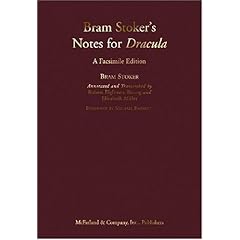
Bram Stoker's Notes for Dracula: A Facsimile Edition
Annotated and Transcribed by ROBERT EIGHTEEN-BISANG and ELIZABETH MILLER
Bram Stoker's notes are housed in the "Rosenbach Museum & Library—a small house that has been converted into a museum and rare-book library on a shady, residential street in the center of Philadelphia." (p 1). Having poured through data, the authors show the plot development of Dracula, from a hodgepodge of character sketches, narrative points, conversations, and places, in a way that makes sense for their readers. It is fun to look at facsimile's of Stoker's hand written entries followed by a "translation" in typed written English.
In a recent article I wrote on Whitby, England and its association with Dracula I found Stoker's Notes to be an invaluable source. Of particular interest I discovered that Stoker and his family stayed in Whitby for several weeks and that many of his notes for Dracula were written there.
"He, his wife Florence and their son Noel, vacationed there during the summer of 1890. They arrived in late July and stayed for at least three weeks. By this time, he had begun his novel and outlined his villain. He had originally planned to have his vampire enter England via Dover but, by the time he returned to London, he had found a name for his vampire, had a new location for his villain’s arrival in England as well as a picturesque background for Lucy’s defilement" (p 288).
Stoker originally planned to have the unfortunate ship, Demeter, come ashore in Dover, but after his stay in the picturesque village of Whitby a new location was used.
This book is so comprehensive that I find it difficult to summarize it in a way that shows what a treasure of information it contains. One of the most daunting tasks for the authors was the deciphering of Stoker's cramped writing. Of course he wasn't writing for others only for himself. But how fortunate that these notes were made, and kept, and found! And now put into a readable form. For any writer, whether a Dracula fan or not, it is fascinating to watch the process unfold. The reader discovers which notes become part of the novel almost in their entirety, others which have a vague resemblance to some circumstance in the story, still more that make no appearance at all. We owe Miller and Eighteen-Bisang a debt for their laborious work on the Notes as well as the detailed footnotes and the extraordinary essays they added which put so much of what occurred in the novel into historical context.
Both thumbs up on this book!
Be sure to visit Elizabeth Miller's site - Dracula's Homepage Here you will find everything you ever wanted to know about the nefarious Count.
No comments:
Post a Comment